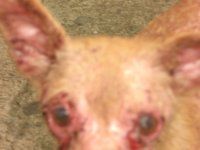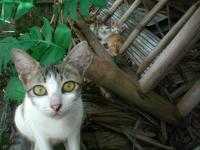Carnivores Have A Really Huge Stomach
Plain and simple, our dogs and cats are carnivores — always have been, always will be.
Although our pets are carnivores, many who feed their dogs and cats a raw meat diet don't fully embrace this fact — usually due to fears. As a result, many feed their carnivore friends a raw meat diet yet make some simple mistakes. One of the mistakes is how much they feed their cats and dogs along with how often. Many either fail to feed enough food or they feed too often.
The reality is that many people have been conditioned by pet food companies to feed a certain amount per day based on the directions on the can or the bag. But this is just not how a carnivore works. Carnivores are meant to eat big — really big — in fact, carnivores are meant to eat a huge meal. While carnivores are meant to eat a huge meal, an adult carnivore only needs one meal per day. Puppies and kittens need more frequent meals.
How much and how often we feed our dogs, cats, puppies and kittens has already been discussed in Part 1 and Part 3, respectively.
In order to really take care of our carnivore friends we must fully embrace the fact that they are carnivores.
65% Versus 15%
Our pets are carnivores. They are not herbivores and they are definitely not human either.
Upon closer examination, we begin to see that our dogs and cats have a stomach that is approximately 65% of their digestive system. That's a whopping huge number. I say approximately because I am sure there are people who will dispute the exact figures — but I am not interested so much in the exact figures as I am in illustrating how carnivores are different to herbivores. By seeing the difference, you will hopefully begin to have a greater understanding of the concepts behind the feeding of our dogs and cats — carnivores.
Now, while our dogs and cats have stomachs that are approximately 65% of their digestive system, a herbivore has a stomach that is about 15% of its digestive system. Think about that for a moment — 65% versus 15% — that's a huge difference in the size of the stomachs.
Here, let me show you the difference:

A carnivore's stomach is approximately 65% of its digestive system

A herbivore's stomach is approximately 15% of its digestive system.
35% Versus 85%
We just discovered that a carnivore's stomach is approximately 65% of its digestive system while a herbivore's stomach is approximately 35% of its digestive system. So what's the 15% versus 85% all about?
This is the next piece of the puzzle to help fully embrace the fact that our pets are carnivores.
A carnivore has a really huge stomach but their intestinal tract is really small — approximately 35% of its digestive system.
On the other paw, a herbivore's stomach is very small but their intestinal tract is quite long — approximately 85% of its digestive system.
![]()
A carnivore's intestinal tract is approximately 35% of its digestive system.
![]()
A herbivore's intestinal is approximately 85% of its digestive system.
Adding 2 and 2 Together While Seeing The Difference Between Grazers and Gorgers
I wish this was more complicated, but it's not.
Realizing the above we begin to picture, in our mind's eye, some interesting things. As you read the following, think of cows, horses and/or goats and how they eat. At the same time, think of how lions, tigers, wolves, coyotes, leopard, etc eat — if you have never seen these animals eat, watch a wildlife documentary.
Let's start with the herbivores. The herbivores are grazers. They have a small stomach and thus they must eat small amounts but often. Thus the reason why herbivores are constantly grazing. Now, since vegetation takes longer to digest that animal protein (meat), herbivores have an exceptionally long intestinal tract so their body can more fully digest and break down the vegetation.
On the other paw, we have the carnivores. A carnivore eats meat and because prey is hard to catch than the grass the herbivores eat, the carnivores eat a big meal once they catch their meal. Let's face it, prey can run away but grass cannot. When you think about it, herbivores have it easy because their food doesn't run away.
Okay, so when the carnivore catches its prey, it knows it had better eat a lot because the carnivore does not know when it will catch its next meal. So the carnivore eats ton of food — sometimes the carnivore eats so much food that it can't move after eating. I've seen wildlife documentaries where the lions, after eating a zebra, have such a plump stomach that the literally cannot move when the safari group passes by. In fact, carnivores have been known to eat as much as 25% of their own body weight.
But getting back to our carnivores. Realizing their stomach is 65% of their digestive system, they eat a huge meal. Realizing that animal protein (meat) requires less time for digestion than vegetation, our carnivores have a very short intestinal tract because their body digests the food fast and then eliminates the meat quickly before any putrefaction can begin within the intestinal tract.
Now, if you were to feed meat to a herbivore, then due to the fact their intestinal tract is so long, the meat would stay in their body too long causing putrefaction. Conversely, if you feed whole vegetation to a carnivore then the vegetation passes through their short intestinal tract before it can be fully digested causing the vegetation to magically reappear in their stools.
This is why, briefly, grains are not good for carnivores and meat is not good for herbivores.
Summary: Feeding A Carnivore
If we control the amount of food our carnivore friends eat, then they are not getting their full meal. Carnivores can eat a huge amount of food — a whopping amount to be exact.
But many, failing to realize the carnivore is meant to eat a huge meal — or due to fears — fail to feed their carnivore friends all the food they should eat.
When we feed a wholesome raw meat diet, we want our pets to walk away from the bowl with some food left in it. If we control the amount they need, we are starving them of nutrition. Our pets are not starving for food, but they are starving for nutrition.
Embrace the fact that your carnivore friends have a ridiculously huge stomach and that they are meant to eat a ridiculously huge meal, but only once per day for adults. Puppies and kittens need more frequent meals, which are discussed in Part 3 of my book.
What's interesting is that when you feed your dogs or cats all that they want of a wholesome raw meat diet, then they will actually reduce their food intake in about 2 or 3 weeks, on average. Even though their stomach is huge, nutritionally, their body will not need as much food to provide the nutrition their body needs and so instinctively, the brain will tell the mouth to stop eating.
Feeding dogs and cats in this way does not work with commercial pet food because the level of nutrition is so poor that the dogs and cats will never stop eating.
You will find, that when you feed your adult carnivore friends like a carnivore that they will be content with 1 meal per day. Furthermore, once it is time for their meal, they are hungry and ready to eat. This makes feeding so much more easy — and it also frees up your time because you don't have to feed your carnivore friends as often.
A Dog or Cat Is Not A Human
The sooner, we as humans, realize and embrace that our carnivore friends are carnivores and not humans, the sooner they will be healthier and the sooner we will have happier and calmer pets.
Learn More About Holistic Health and Nutrition For Pets
Keep reading by choosing another page or topic.
- Herbal and Homeopathic Remedies for Dogs and Cats
- Introduction
- Carnivores Have A Really Big Stomach
- What Can I Do To Have My Pet Eat More?
- Grains Should Not Be Fed To Dogs and Cats
- Chew or False: Dry Foods Do Not Clean Teeth
- Commercial Pet Food: Fast Food For Dogs and Cats
- Diet: One of The Keys To Dog Whispering
- Puppies and Kittens: Detoxification, Worms and Discipline
- The Funny Thing About Health
- Yin and Yang Easily Explained, Easily Understood
- The 5 Elements — An Introduction
- The Five Elements Explored A Little More
- Yin and Yang In The Diet
- Feeding Fish To Dogs and Cats
- The Yellow Emperor and Other Early Chinese Healers
- Feeding Whole Prey To Dogs and Cats
- Feeding Bones: Thoughts About Calcium and More
- Heartworm
- Natural Bug Lawn Spray
- The Rabies Vaccination: Is It Really Effective
- Are Antibiotics Really Needed After Surgery?
- The Great Pet Food Debate
- Cats Need To Scratch
- MSG In Foods
- Random Bits of Information
- The Yogic Triple Breath For Health
- Solving Constipation In Dogs and Cats
- Pet Food Recalls and Alerts
 Meet Jumbo, the participant in
Meet Jumbo, the participant in 